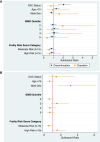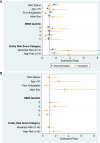Evaluating the effect of inequalities in oral anti-coagulant prescribing on outcomes in people with atrial fibrillation
- PMID: 38572087
- PMCID: PMC10989660
- DOI: 10.1093/ehjopen/oeae016
Evaluating the effect of inequalities in oral anti-coagulant prescribing on outcomes in people with atrial fibrillation
Abstract
Aims: Whilst anti-coagulation is typically recommended for thromboprophylaxis in atrial fibrillation (AF), it is often never prescribed or prematurely discontinued. The aim of this study was to evaluate the effect of inequalities in anti-coagulant prescribing by assessing stroke/systemic embolism (SSE) and bleeding risk in people with AF who continue anti-coagulation compared with those who stop transiently, permanently, or never start.
Methods and results: This retrospective cohort study utilized linked Scottish healthcare data to identify adults diagnosed with AF between January 2010 and April 2016, with a CHA2DS2-VASC score of ≥2. They were sub-categorized based on anti-coagulant exposure: never started, continuous, discontinuous, and cessation. Inverse probability of treatment weighting-adjusted Cox regression and competing risk regression was utilized to compare SSE and bleeding risks between cohorts during 5-year follow-up. Of an overall cohort of 47 427 people, 26 277 (55.41%) were never anti-coagulated, 7934 (16.72%) received continuous anti-coagulation, 9107 (19.2%) temporarily discontinued, and 4109 (8.66%) permanently discontinued. Lower socio-economic status, elevated frailty score, and age ≥ 75 were associated with a reduced likelihood of initiation and continuation of anti-coagulation. Stroke/systemic embolism risk was significantly greater in those with discontinuous anti-coagulation, compared with continuous [subhazard ratio (SHR): 2.65; 2.39-2.94]. In the context of a major bleeding event, there was no significant difference in bleeding risk between the cessation and continuous cohorts (SHR 0.94; 0.42-2.14).
Conclusion: Our data suggest significant inequalities in anti-coagulation prescribing, with substantial opportunity to improve initiation and continuation. Decision-making should be patient-centred and must recognize that discontinuation or cessation is associated with considerable thromboembolic risk not offset by mitigated bleeding risk.
Keywords: Atrial fibrillation; Pharmacoepidemiology; Real-world data; Stroke.
© The Author(s) 2024. Published by Oxford University Press on behalf of the European Society of Cardiology.
Conflict of interest statement
Conflict of interest: R.J.M., F.M., G.C., T.J.Q., and C.G. have received research grants from Bristol Myers Squibb and Pfizer UK. T.J.Q. is a data monitoring committee chair for Novo Nordisk. R.T. is currently employed by Pfizer UK and owns Pfizer stocks/shares. K.G.P. is currently employed by Bristol Myers Squibb. S.L. was previously employed by Bristol Myers Squibb and owns stocks and shares in Pfizer and Bristol Myers Squibb.
Figures



 16.49
16.49  6.48
6.48  17.75
17.75  6.66
6.66  8.43.
8.43.

 11.41
11.41  12.49. Analyses were also adjusted for time off anti-coagulation.
12.49. Analyses were also adjusted for time off anti-coagulation.Similar articles
-
Delay and Pay? Healthcare Costs Associated with Late Oral Anti-coagulant Prescribing in People with Atrial Fibrillation.Pharmacoeconomics. 2024 Nov;42(11):1241-1253. doi: 10.1007/s40273-024-01419-2. Epub 2024 Aug 2. Pharmacoeconomics. 2024. PMID: 39093500 Free PMC article.
-
Risk Levels and Adverse Clinical Outcomes Among Patients With Nonvalvular Atrial Fibrillation Receiving Oral Anticoagulants.JAMA Netw Open. 2022 Aug 1;5(8):e2229333. doi: 10.1001/jamanetworkopen.2022.29333. JAMA Netw Open. 2022. PMID: 36044214 Free PMC article.
-
[A comparison of CAS risk model and CHA2DS2-VASc risk model in guiding anticoagulation treatment in Chinese patients with non-valvular atrial fibrillation].Zhonghua Xin Xue Guan Bing Za Zhi. 2022 Sep 24;50(9):888-894. doi: 10.3760/cma.j.cn112148-20210826-00740. Zhonghua Xin Xue Guan Bing Za Zhi. 2022. PMID: 36096706 Clinical Trial. Chinese.
-
Stroke Risk Stratification Schemes in Atrial Fibrillation in the Era of Non- Vitamin K Anticoagulants: Misleading and Obsolete, At Least for the "Low-Risk" Patients?Curr Drug Targets. 2017 Nov 30;18(16):1852-1865. doi: 10.2174/1389450117666160905111822. Curr Drug Targets. 2017. PMID: 27593686 Review.
-
Direct Oral Anticoagulants vs. Warfarin in Latin American Patients With Atrial Fibrillation: Evidence From Four post-hoc Analyses of Randomized Clinical Trials.Front Cardiovasc Med. 2022 Mar 4;9:841341. doi: 10.3389/fcvm.2022.841341. eCollection 2022. Front Cardiovasc Med. 2022. PMID: 35310968 Free PMC article.
Cited by
-
Prothrombotic Rebound After Discontinuation of Direct Oral Anticoagulants Therapy: A Systematic Review.J Clin Med. 2024 Nov 3;13(21):6606. doi: 10.3390/jcm13216606. J Clin Med. 2024. PMID: 39518744 Free PMC article. Review.
-
Could the Inflation Reduction Act Maximum Fair Price Hurt Patients?J Health Econ Outcomes Res. 2024 Nov 27;11(2):154-160. doi: 10.36469/001c.125251. eCollection 2024. J Health Econ Outcomes Res. 2024. PMID: 39629268 Free PMC article.
References
-
- Kirchhof P, Benussi S, Kotecha D, Ahlsson A, Atar D, Casadei B, Castella M, Diener H-C, Heidbuchel H, Hendriks J, Hindricks G, Manolis AS, Oldgren J, Popescu BA, Schotten U, Van Putte B, Vardas P, Agewall S, Camm J, Baron Esquivias G, Budts W, Carerj S, Casselman F, Coca A, De Caterina R, Deftereos S, Dobrev D, Ferro JM, Filippatos G, Fitzsimons D, Gorenek B, Guenoun M, Hohnloser SH, Kolh P, Lip GYH, Manolis A, McMurray J, Ponikowski P, Rosenhek R, Ruschitzka F, Savelieva I, Sharma S, Suwalski P, Tamargo JL, Taylor CJ, Van Gelder IC, Voors AA, Windecker S, Zamorano JL, Zeppenfeld K. 2016 ESC guidelines for the management of atrial fibrillation developed in collaboration with EACTS. Eur J Cardiothorac Surg 2016;50:e1–e88. - PubMed
-
- Spivey CA, Liu X, Qiao Y, Mardekian J, Parker RB, Phatak H, Masseria C, Kachroo S, Abdulsattar Y, Wang J. Stroke associated with discontinuation of warfarin therapy for atrial fibrillation. Curr Med Res Opin 2015;31:2021–2029. - PubMed
-
- Rivera-Caravaca JM, Roldan V, Esteve-Pastor MA, Valdes M, Vicente V, Lip GYH, Marín F. Cessation of oral anticoagulation is an important risk factor for stroke and mortality in atrial fibrillation patients. Thromb Haemost 2017;117:1448–1454. - PubMed
-
- Chai-Adisaksopha C, Hillis C, Monreal M, Witt DM, Crowther M. Thromboembolic events, recurrent bleeding and mortality after resuming anticoagulant following gastrointestinal bleeding. A meta-analysis. Thromb Haemost 2015;114:819–825. - PubMed
LinkOut - more resources
Full Text Sources
Miscellaneous

